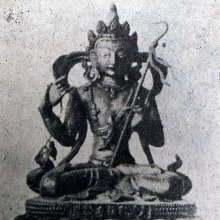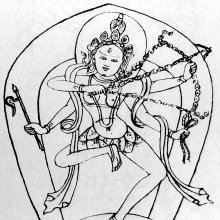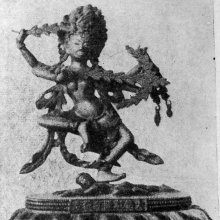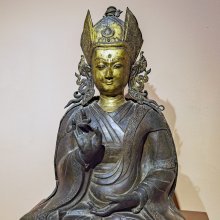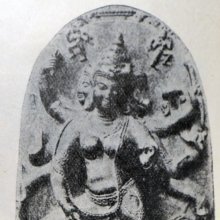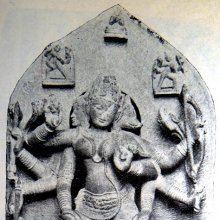Uddiyana, Uḍḍiyāna, Uḍḍiyāṇa, Uḍḍīyana: 14 definitions
Introduction:
Uddiyana means something in Buddhism, Pali, Hinduism, Sanskrit. If you want to know the exact meaning, history, etymology or English translation of this term then check out the descriptions on this page. Add your comment or reference to a book if you want to contribute to this summary article.
Images (photo gallery)
(+2 more images available)
In Hinduism
Shaktism (Shakta philosophy)
Source: Wisdom Library: ŚāktismUḍḍiyāna (उड्डियान) is the name of a Śāktapīṭha mentioned in the Kulārṇavatantra. The Kulārṇava-tantra is an important 11th century work for the Kaula school of Śāktism. It refers to eighteen such Śākta-pīṭhas (e.g. Uḍḍiyāna) which is defined as a sacred sanctuary of Devī located here on earth. According to legend, there are in total fifty-one such sanctuaries (pīṭha) on earth, created from the corresponding parts of Devī’s body,
Source: Google Books: ManthanabhairavatantramUḍḍiyāna (उड्डियान) (or Uḍḍiyānaka) is another name for Oḍḍiyāna (Oḍḍiyānaka) which is a Mahāpīṭha (main sacred seat) and refers to one of the ten places visited by the Goddess on her pilgrimage, according to Tantric texts such as the Kubjikāmata-tantra, the earliest popular and most authoritative Tantra of the Kubjikā cult.—Accordingly, “[...] Then content and profound, Kujeśvarī who is endowed with the quality of discernment and whose creation (takes place) by many means said this: “As (I) have flown up (oḍḍitā) (here) within Oḍḍīśa, therefore this (place will be known) as Oḍḍiyānaka”.
According to the Ṣaṭsāhasrasaṃhitā: “This is (called) Uḍḍiyāna because (the goddess) flew up by means of it within Uḍḍīśa”. Note: Sanderson translates the entire line as: “This is (called) Uḍḍiyāna because the (Siddha) Uḍḍīśa ascended (here) into the sky”. [...] The commentary does indeed appear to say that it is Uḍḍīśa who is ascending, not the goddess. However, this is probably not so, we could just as well emend the first word to uḍḍīśe. This would make more sense.
Note: Uḍḍiyāna is probably the best “average” form of the name across the different schools. It is the one generally preferred in the Kālīkrama sources and may well be the original one. But note that Śitikaṇṭha uses two spellings, Uḍḍiyāna and Oḍḍiyāna, in the same sentence (op. cit. p. 4950). Clearly the latter is a common variant and it is this one or some variant beginning with the same vowel that is, on the whole, the main spelling in the Kubjikā sources.

Shakta (शाक्त, śākta) or Shaktism (śāktism) represents a tradition of Hinduism where the Goddess (Devi) is revered and worshipped. Shakta literature includes a range of scriptures, including various Agamas and Tantras, although its roots may be traced back to the Vedas.
In Buddhism
Tibetan Buddhism (Vajrayana or tantric Buddhism)
Source: Google Books: Remembering the Lotus-BornUḍḍiyāna (उड्डियान).—By the fourteenth century the Testament of Padmasambhava eulogizes Uḍḍiyāna as a paradise spread over two-thirds of the world’s total landmass. With close proximity to both the Karakorum and Khyber passes as well as the wealth of the Silk Roads that flowed through them, this region flourished for centuries under the Buddhist empire of Gandhāra that enjoyed its apogee from the first of to fifth centuries C.E. With merchants and commerce pouring into the realm, varius strains of Indian Buddhism arrived as well ,and monastic institutions of both the earlier and later Buddhist tradtitions benefited from signifcant patronage.
Source: archive.org: The Indian Buddhist IconographyUḍḍiyāna (उड्डियान) or Oḍiyāna refers to one of the four pīṭhas (sacred spots) according to the Sādhanamālā.—It is difficult to say from what exact locality Tantrism took its origin. In the Sādhanamālā are mentioned the four Pīṭhas or sacred spots of the Vajrayānists, namely, Kāmākhyā, Sirihaṭṭa, Pūrṇagiri and Uḍḍiyāna. The Tibetan authorities are of opinion that the Tantric Buddhism originated from Uḍḍiyāna, The location of Uḍḍiyāna thus is important forthe history of the Buddhist Tantric literature.
Uḍḍiyāna is mentioned in the Sādhanamālā rather frequently. The earliest manuscript of the Sādhanamālā is dated in the Newari Era 285 which is equivalent to A. D. 1165. In this work Uḍḍiyāna is connected with the Sādhana of Kurukullā, Trailokyavaśaṃkara, Mārīcī and Vajrayoginī. The Sādhanamālā also connects Uḍḍiyāna with such Tantric authors as Saraha. The Jñānasiddhi of Indrabhūti is stated in the last colophon as having started from Uḍḍiyāna (Oḍiyāna).
Uḍḍiyāna is possibly identified with Vajrayoginī.—Uḍḍiyāna being one of the four Pīṭhas sacred to Vajrayoginī should be at least near Kāmākhyā (Kāmarūpa), and Sirihaṭṭa (Sylhet) in Assam and it is not unusual to think that all these four Pīṭhas received their sanctity from temples dedicated to Vajrayoginī. Thus Uḍḍiyāna has to be located in Eastern and Assam area. [...] It is possible to spot [Uḍḍiyāna] which is connected with Vajrayoginī. Thus it becomes evident that the present village Vajrayoginī was originally known as Uḍḍiyanā but as the deity Vajrayoginī became more popular later, the original name gradually disappeared giving place to the name of the deity. Tantrism of the Buddhists therefore originated here in Uḍḍiyanā-Vajrayoginī, and thence was transmited to the rest of India.
Source: Lotsawa House: A Guide to Uḍḍiyāna
Uḍḍiyāna (उड्डियान).—Long ago, while king Bharthari of Uḍḍiyāna (Ujjain) was resting in samādhi here, local spirits began causing him trouble. A lightning bolt struck a pillar, splitting it down the middle. The mighty king held up the pillar with his two hands, leaving handprints in the stone. To this day, through great blessings, the pillars are still suspended in the air.
Source: ÖAW: Uḍḍiyāna: legends and historyUḍḍiyāna (उड्डियान) is mostly known as the legendary homeland of Padmasambhava, the great teacher who, summoned to Tibet by the king Trisong Detsen in the mid-eight century CE, introduced there an esoteric form of Buddhism – an inextricable melding of magic and mysticism – which is thought to be at the roots of Vajrayāna. Much less is known about Uḍḍiyāna as a historical region, which archaeology has long since identified with an area centred on modern-day Swat (north-western Pakistan).
Source: Shams-i-bala and The Historical Shambhala Kingdom: Udegram: Uḍḍiyāna & the Palace of King IndrabhutiUḍḍiyāna (उड्डियान).—The Chinese pilgrim Song Yun, who visited the country in 520 AD, convey to us a vivid picture of Uḍḍiyāna: “the pleasant weather, the abundance of crops, the sound of the bells that in the evening clang from the many Buddhist monasteries, the colours of the flowers that, everywhere and in every season, the land produces and people offer to the Buddha”.

Tibetan Buddhism includes schools such as Nyingma, Kadampa, Kagyu and Gelug. Their primary canon of literature is divided in two broad categories: The Kangyur, which consists of Buddha’s words, and the Tengyur, which includes commentaries from various sources. Esotericism and tantra techniques (vajrayāna) are collected indepently.
Languages of India and abroad
Sanskrit dictionary
Source: DDSA: The practical Sanskrit-English dictionaryUḍḍiyāna (उड्डियान).—A particular position of the fingers.
Derivable forms: uḍḍiyānam (उड्डियानम्).
--- OR ---
Uḍḍīyana (उड्डीयन).—Flying up.
Derivable forms: uḍḍīyanam (उड्डीयनम्).
Source: Cologne Digital Sanskrit Dictionaries: Edgerton Buddhist Hybrid Sanskrit DictionaryUḍḍiyāna (उड्डियान) or Oḍḍiyāna.—: Sādhanamālā 361.16.
Source: Cologne Digital Sanskrit Dictionaries: Cappeller Sanskrit-English DictionaryUḍḍīyana (उड्डीयन).—[neuter] = uḍḍayana.
Source: Cologne Digital Sanskrit Dictionaries: Monier-Williams Sanskrit-English Dictionary1) Uḍḍiyāṇa (उड्डियाण):—m. Name of a place.
2) Uḍḍiyāna (उड्डियान):—n. a particular position of the fingers.
3) Uḍḍīyana (उड्डीयन):—[=uḍ-ḍīyana] [from uḍ-ḍī] n. flying up, soaring, [Mahābhārata]
[Sanskrit to German]
Sanskrit, also spelled संस्कृतम् (saṃskṛtam), is an ancient language of India commonly seen as the grandmother of the Indo-European language family (even English!). Closely allied with Prakrit and Pali, Sanskrit is more exhaustive in both grammar and terms and has the most extensive collection of literature in the world, greatly surpassing its sister-languages Greek and Latin.
Kannada-English dictionary
Source: Alar: Kannada-English corpusUḍḍiyāṇa (ಉಡ್ಡಿಯಾಣ):—[noun] = ಉಡ್ಡಿಯಾಣಬಂಧ [uddiyanabamdha].
Kannada is a Dravidian language (as opposed to the Indo-European language family) mainly spoken in the southwestern region of India.
See also (Relevant definitions)
Starts with: Uddiyanabandha, Uddiyanaka, Uddiyanakurukulla, Uddiyanamarici.
Full-text (+27): Uddiyanabandha, Oddiyana, Bandha, Odiyana, Kamakhya, Sirihatta, Mangalapura, Udiyana, Trailokyavashankaralokeshvara, U-rgyan, Uddiyanaka, Dattatreyayogashastra, O-rgyan, Swat Valley, Mahabandha, Purnagiri, Parakala, Vajrayogini, Kularnavatantra, Kunti.
Relevant text
Search found 16 books and stories containing Uddiyana, Uḍḍiyāna, Uḍḍiyāṇa, Uḍḍīyana, Ud-diyana, Uḍ-ḍīyana, Uḍḍīyāna; (plurals include: Uddiyanas, Uḍḍiyānas, Uḍḍiyāṇas, Uḍḍīyanas, diyanas, ḍīyanas, Uḍḍīyānas). You can also click to the full overview containing English textual excerpts. Below are direct links for the most relevant articles:
Jnaneshwari (Bhavartha Dipika) (by Ramchandra Keshav Bhagwat)
Verse 18.52 < [Chapter 18 - Moksha-sannyasa-yoga]
Verse 13.7 < [Chapter 13 - Kshetra and Kshetrajna Yoga]
Stupas in Orissa (Study) (by Meenakshi Chauley)
Uddiyana Pitha (in Tantric Buddhism) < [Chapter 2]
Tantric Buddhism in Orissa (Introduction) < [Chapter 2]
Vajrayana form of Buddhism < [Chapter 2]
The Indian Buddhist Iconography (by Benoytosh Bhattachacharyya)
Figure 114 - (Avalokiteśvara): Trailokyavaśaṅkara
Figure 121-122 - Emanations of Amitābha: Kurukullā
Figure 152-155 - Emanations of Vairocana: Aṣṭabhuja and Daśabhujasita Mārīcī
The Great Chariot (by Longchenpa)
The Agni Purana (by N. Gangadharan)
